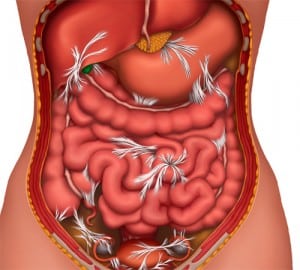 A partial or total blockage in your intestines known as a bowel obstruction can cause waste to move improperly through the bowel and out of the body.
A partial or total blockage in your intestines known as a bowel obstruction can cause waste to move improperly through the bowel and out of the body.
Immediate treatment is needed to remove the blockage. This can relieve painful symptoms and prevent serious complications such as tissue death or rupture of the small bowel.
Without treatment, a bowel obstruction can be fatal.
Symptoms of Small Bowel Obstruction
- Abdominal cramping and pain
- Abdominal swelling and bloating
- Nausea and vomiting
- Inability to pass gas
- Inability to pass stool (constipation)
- Diarrhea
Causes of small bowel obstruction
- Scar tissue that forms after surgery or infection
- Hernia (weakness or tear in the wall of the abdomen) can cause a portion of the small bowel to push out and appear as a visible bulge under the skin
- Certain medical conditions, including the intussusceptions (a portion of the bowel slides inside another portion) and Crohn’s disease (illness that causes inflammation and sores to form in the digestive tract). Abnormal tissue growths (tumor) can form on the inside or outside of the small bowel, and are usually due to cancer.
Call your doctor immediately
- Abdominal swelling or cramping that won’t go away
- Inability to pass stool or gas
- Nausea or vomiting (especially if the vomit looks or smells like stool)
Tests to confirm a small bowel obstruction
- X‐ray and CT scan imaging for pictures of the small bowel
- Blood tests to check for infection, dehydration or other problems
- Upper gastrointestinal series with small bowel follow-‐through
Treatment for small bowel obstruction
- Elimination of food or drink by mouth to allow the bowels to rest Intravenous fluids and medications to relieve symptoms and prevent infections
- A gastric tube inserted through your nose and into your stomach for removing extra gas and fluid in your stomach and bowels, to relieve symptoms such as pain and swelling
In severe cases when the small bowel is almost or totally blocked, surgery is performed to remove the blockage and any portions of the bowel with tissue death and any necessary repair. Many people recover with no lasting effects. But, if a long portion of the bowel is removed in surgery, there is a greater chance for lifelong digestive problems such as irregular bowel movements.
Symptoms of Large Bowel Obstruction
- Abdominal cramping and pain
- Abdominal swelling and bloating
- Inability to pass gas
- Inability to pass stool (constipation)
Causes of large bowel obstruction
- Cancer
- Twisting of the bowel
- A narrowing (stricture) of the bowel caused by conditions such as diverticulitis and Crohn’s disease
- Sliding of a portion of the bowel into another portion (intussusceptions)
- A hard lump of stool (impacted feces)
Call your doctor immediately
- Fever of 100.4 or higher
- Abdominal swelling or cramping that won’t go away
- Inability to pass stool or gas
- Rectal bleeding
Tests to confirm a large bowel obstruction
- X‐ray and CT scan imaging for pictures of the large bowel.
- Blood tests to check for infection, dehydration or other problems.
- Air enema or contrast enema to take pictures of the inside of the large bowel to obtain clear x-‐ray images Colonoscopy to check for problems inside the large bowel and collect any tissues samples for biopsy that might be necessary.
Treating large bowel obstruction
- Elimination of food and drink by mouth to allow the bowels to rest
- Intravenous fluids and medication to relieve symptoms and prevent infections
- A gastric tube inserted through your nose and into your stomach for removing extra gas and fluid in your stomach and bowels, to relieve symptoms such as pain and swelling. An air or contrast enema may be done as well. It can remove gas or help clear a blockage.
Colonoscopy may be performed as a procedure to straighten a twisted colon or insert a stent to widen a narrowed area. More often, surgery is performed to remove the blockage and any portion of the bowel that has died due to lack of blood flow. If a long portion of the bowel is removed, a small opening (stoma) may need to be made in the abdomen to provide a new way for waste to leave the body. The stoma may be temporary or permanent depending on the cause of the blockage, other repair may be done as well.
After treatment, many people recover with no lasting effects. If a long portion of the bowel was removed, you are at a higher risk of lifelong digestive problems such as irregular bowel movements. If you have cancer or other conditions, you will need to continue seeing your doctor for treatment.
Helpful Links

